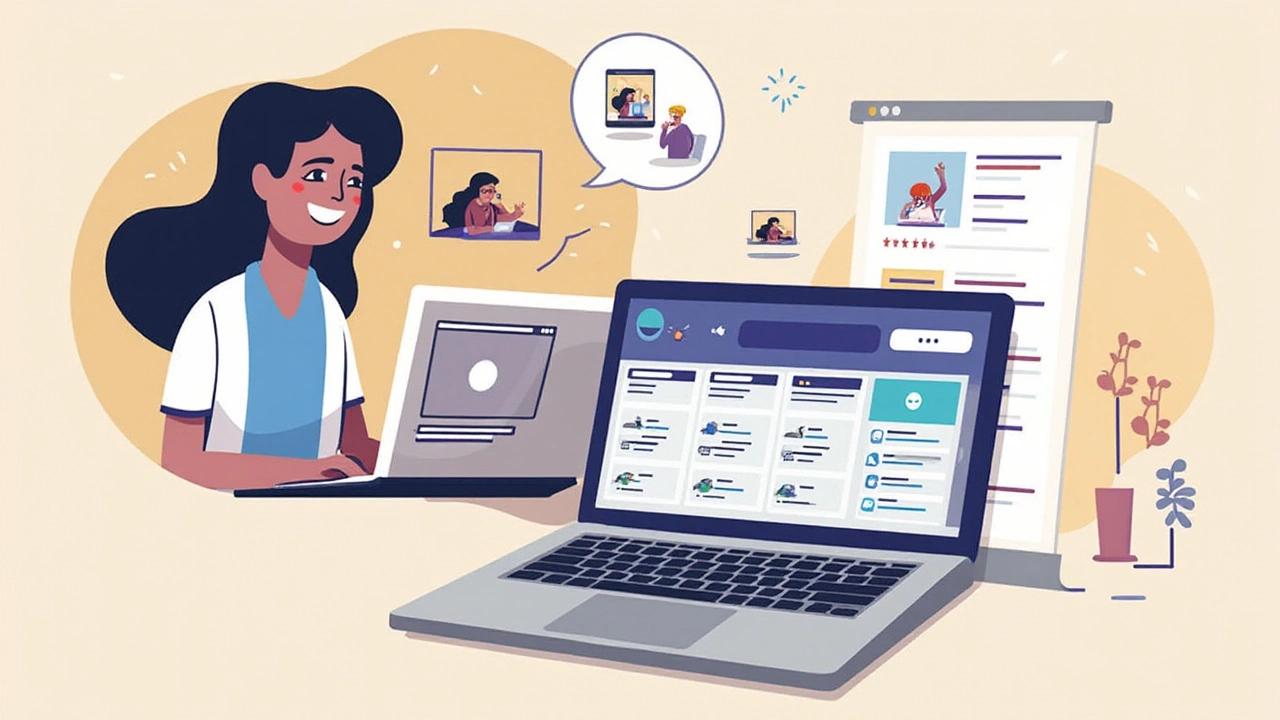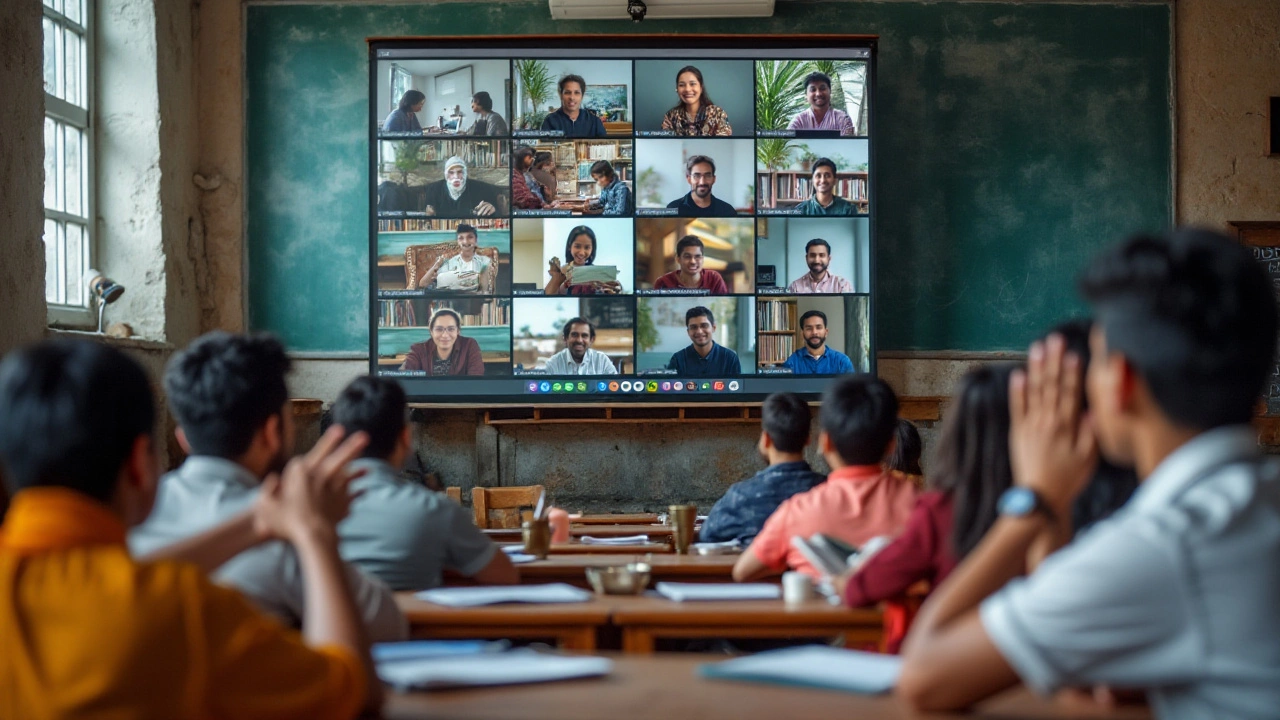In the digital age, the way we learn has evolved dramatically, with technology at the forefront of this transformation. Zoom has become one of the most talked-about tools in online education, offering a way to connect learners and educators across the globe. But can it really be considered an e-learning platform?
Zoom wasn’t originally designed as an educational tool, yet it has swiftly become essential in many classrooms. With the ability to host live video sessions, share screens, and connect interactive participants, it fits several criteria of virtual learning tools. However, it lacks some of the specialized features found in platforms dedicated to e-learning.
Examining Zoom's capabilities reveals both strengths to capitalize on and limitations that need to be addressed. By understanding these elements, educators can determine how best to integrate Zoom into their teaching strategies. Let's uncover what Zoom offers to the world of e-learning and how it can coexist with other educational technologies.
- Understanding Zoom's Role
- Features Facilitating E-Learning
- Strengths of Zoom in Education
- Limitations and Challenges
- Tips for Effective Use
Understanding Zoom's Role
In the ever-evolving landscape of digital education, Zoom has carved out a significant role, not only as a tool enabling virtual meetings but also as a key enabler of modern e-learning. Initially designed to facilitate seamless communication through video conferencing, Zoom’s utility transcends its original purpose. Its rise to prominence, especially during the global shift to remote learning, is a testament to its adaptability and the pressing demand for reliable digital solutions. The platform's capacity to bring people together from disparate locations has made it indispensable for educational institutions grappling with maintaining continuity in a disrupted educational environment.
One of the most compelling aspects of Zoom’s function in education is its ability to transform a traditional classroom into an interactive virtual experience. Lectures that once required physical attendance can now transpire in a digital sphere, often with increased accessibility for students all around the globe. This transition has proven especially advantageous for learners in remote areas or those who might face mobility challenges. Moreover, Zoom's user-friendly interface ensures that educators and students alike can participate without an arduous tech learning curve, making it an attractive option for many schools and universities seeking quick implementation. As The Washington Post once noted, "Zoom has opened doors for education, overcoming geographical and physical barriers like never before."
However, Zoom’s role in e-learning extends beyond just convenience. Its integration into the educational workflow can foster an environment ripe for interactive, engaging pedagogy. Features like breakout rooms offer educators the chance to organize students into smaller groups for focused activities, replicating small group discussions that are an integral part of traditional learning settings. The platform’s chat function allows for real-time interaction and feedback, encouraging student participation and fostering a more inclusive learning environment. Live polls provide opportunities for instant feedback, inspiring a dynamic exchange of ideas that can significantly enhance the learning process.
Despite its contributions, it's essential to recognize that Zoom isn't a complete standalone education platform. It lacks some e-learning specific features such as built-in assessment tools, grade books, or pre-packaged learning modules, which are trademarks of dedicated virtual learning platforms like Moodle or Blackboard. Yet, Zoom’s flexibility allows it to integrate seamlessly with these platforms, creating a hybrid system that leverages the strengths of all involved technologies. Through integration with Learning Management Systems (LMS), educators can harness Zoom's capabilities while supplementing the experience with tailored educational content.
Understanding Zoom's role in e-learning isn't just about acknowledging its convenience and functionality; it also involves appreciating its impact on educational accessibility. As digital learning becomes more embedded in mainstream education, the role of tools like Zoom will only become more pronounced. The development of the digital classroom continues to evolve, and with it, Zoom adapts, creating a new dimension of educational opportunities previously deemed impossible. Educators and policymakers now look towards innovative ways to integrate Zoom effectively, ensuring that its potential is maximized for educational benefit.
Features Facilitating E-Learning
Zoom has quickly become a household name in the realm of online education, valued for its simplicity, adaptability, and widespread accessibility. The platform's capability to support virtual classrooms is perhaps its most pronounced feature, allowing educators to replicate the communal feel of face-to-face interactions within their own digital settings. This transformation is enabled by several specific features that cater to the unique needs of the educational sphere. Scheduling and holding consistent live classes becomes seamless with Zoom's calendar integrations, keeping everything organized for both educators and students. Such convenience ensures the educational sessions are not only set on time but also less prone to the usual disruptions associated with technical misalignments.
On the interactive front, Zoom introduces unique tools like real-time polling and a built-in chat function, which allow students to engage actively with the course material and with each other. These features are significant in realizing a participatory learning environment, encouraging student voices to be heard even in a virtual setting. Zoom also offers a range of functionalities specifically geared to assist those in the teaching profession. The screen sharing option lets educators display their slides or educational content without any hitches, ensuring that all participants have the information needed right in front of them. Additionally, the whiteboard feature allows educators to visualize concepts as if they were in a physical classroom, offering students a familiar format for learning new ideas.
What sets Zoom apart is its capacity to host breakout rooms, which add a layer of collaborative learning to online education. These small, breakout groups allow for deeper discussions and smoother transitions from large group teachings to smaller, focused conversations that enhance understanding. Leveraging this feature is not only a boon for teachers aiming to implement group activities but also encourages peer-to-peer learning, which has been found to be highly effective academically. In fact, according to an EdTech review conducted in 2023, institutions utilizing Zoom breakout rooms saw a 25% increase in student engagement metrics. This clearly shows how Zoom can facilitate a more involved learning experience.
In terms of accessibility, Zoom covers considerable ground by catering inclusively to a diverse range of users. Closed captioning aids hearing-impaired students, ensuring all participants, regardless of physical ability, can partake fully in the session. Recordings of sessions are another boon, allowing students who were unable to attend live or who want to review the material to access past content at their corporate convenience. This flexibility not only adds to the appeal of Zoom for educational use but highlights its role as a learning resource that transcends the constraints of time and location.
Despite not being originally designed for educational purposes, Zoom's functionalities have adapted remarkably to fill that niche. The platform doesn’t replace traditional learning tools but rather complements them by bringing flexibility and engagement to the forefront. As technology evolves, it's certain that Zoom will continue to integrate features that further empower educators and enhance virtual learning experiences.

Strengths of Zoom in Education
Zoom, now a household name, has positioned itself as a flexible powerhouse in the realm of e-learning. One significant strength lies in its robustness and reliability, crucial factors in the digital education landscape. Zoom's ability to handle large user volumes without noticeable downtime has made it a preferred choice for institutions globally. In an era where constant connectivity is demanded, Zoom's infrastructure offers teachers and students uninterrupted virtual classrooms.
A key feature that highlights Zoom's relevance in education is its user-friendly interface. Intuitive design ensures both tech-savvy and non-tech users find it straightforward to operate. This simplicity reduces the learning curve, allowing educators to focus more on content delivery rather than the mechanics of the software. Students, regardless of their location, can access classes with ease, reducing barriers to entry and ensuring more inclusive education.
The rich suite of interactive tools that Zoom provides also bolsters its educational capabilities. Features like screen sharing, breakout rooms, and polls enhance engagement, offering versatile ways to conduct lessons. These tools enable teachers to simulate traditional classroom settings and encourage participation, all from the comfort of one’s home. Zoom, with its real-time interaction capabilities, mimics a classroom environment by enabling questions to be asked and answered promptly, leading to a dynamic educational experience.
The platform's integration capabilities with various third-party applications enrich the teaching and learning experience further. From linking with learning management systems (LMS) to tools for educational assessments, Zoom's interoperability ensures that educators can customize their virtual classrooms to meet specific pedagogical outcomes. These integrations can help in crafting a seamlessly connected e-learning ecosystem, enhancing productivity and learning effectiveness.
Moreover, Zoom's security features have been constantly evolving, addressing concerns of digital safety that often plague online platforms. The application emphasizes encryption and privacy controls, which are essential in safeguarding sensitive educational data and maintaining a secure virtual learning space. This focus on security reassures institutions and protects the integrity of educational content.
In a testimonial from Dr. Lisa Roberts, an educator with over two decades of experience, she emphasized, "
Zoom has revolutionized the way I conduct my classes. Its dependability and range of features empower me to create an engaging learning environment, something that was imperative during the shift to online education." Her words encapsulate the transformative potential Zoom holds in reimagining modern education practices.
The list of Zoom's contributions to the educational sector would be incomplete without mentioning its global accessibility. The platform supports multiple languages, catering to a diverse international student body. This linguistic versatility allows educators to reach wider audiences, contributing to breaking down geographical and language barriers in education. For institutions aiming to expand their outreach, Zoom offers a reliable and effective solution.
Limitations and Challenges
When considering Zoom as a platform for eLearning, several limitations and challenges surface, primarily due to its original design as a video conferencing tool rather than an educational software. One significant challenge is the lack of comprehensive learning management system (LMS) features. Educators find it hard to track student progress, assign and grade coursework, or manage a curriculum, as these are functionalities often missing in Zoom. This limitation necessitates the integration of other software tools to create a holistic learning environment, a process that can become cumbersome and fragmented for educators and students alike.
Moreover, Zoom heavily relies on stable and high-speed internet connectivity, which is not always available in all regions, creating a substantial barrier for learners in remote or underprivileged areas. This lack of accessibility highlights a growing digital divide, with students who have reliable internet connections benefitting more from the platform than those without. Video and audio quality can degrade significantly if bandwidth is low, leading to a subpar educational experience that can disrupt learning continuity and comprehension.
User engagement also poses a challenge as maintaining student interest through a screen is inherently more difficult than in physical classrooms. Zoom's platform lacks interactivity and gamification elements often present in dedicated eLearning platforms, which are crucial for holding students' attention. Educational experts have expressed concerns that learners can easily become passive participants, especially in large lecture-style sessions where interaction is limited. As a result, fostering active participation becomes a priority that educators must creatively address.
There are also privacy and security concerns that have been associated with Zoom, particularly during its rapid rise in use. Incidents of unauthorized entries into virtual classrooms, popularly termed 'Zoom-bombing,' raised alarms and necessitated stringent privacy protocols. Though Zoom has since implemented better controls, educators must remain vigilant to protect sensitive student information and ensure a secure learning environment. Spartan security measures are not enough to prevent such breaches, thus requiring extra attention from users to safeguard the virtual learning space.
"The adoption of Zoom for educational purposes showcases both the innovative drive of institutions and the need for adaptation in the face of abrupt technological demands," says Dr. Amy Wilson, an educational technology researcher.
Integrating Zoom with traditional methods can often lead to technological fatigue, termed 'Zoom fatigue,' characterized by the mental exhaustion arising from prolonged virtual interaction. This phenomenon is now widely acknowledged, with educators feeling pressured to design multimedia-rich content to maintain enthusiasm. The challenge lies in finding a balance, ensuring that the tool enhances learning rather than detracting from it. Many teachers consider if online education over Zoom can truly match the depth of in-person learning experiences.

Tips for Effective Use
To harness the full potential of Zoom as a learning tool, it's crucial to go beyond the basics and explore advanced functionalities that enhance the educational experience. A well-structured online class can significantly impact students' engagement and comprehension. Start by planning your sessions meticulously. Before going live, prepare a detailed outline of the lesson, including key points, activities, and the desired learning outcomes. Having a clearly defined agenda keeps the session focused and ensures that participants are aware of what to expect.
In addition to preparation, maintaining student engagement is paramount. Zoom offers features such as breakout rooms, which can be used for group discussions and collaborative activities. Divide participants into smaller groups to encourage active participation and individualized attention. This strategy mirrors the dynamics of a traditional classroom where students benefit from personalized interactions. For lectures, using the annotation tools provided by Zoom can make sessions more interactive. Illustrate concepts in real-time with virtual whiteboards or highlight important areas on shared documents. These interactive tools can facilitate better understanding and retention of information.
The seamless operation of technology is critical to avoiding disruptions. Check your equipment, such as the camera, microphone, and stable internet connectivity, well in advance. For larger classes, consider co-hosting with a teaching assistant to manage technical issues promptly. Being proactive and prepared can eliminate many potential hiccups during the session. Regularly test these setups to ensure smooth operation. If you’re implementing new tools or platforms in your session, conduct a test run to become familiar with their functionalities.
According to a study by Educause, "Interactive capabilities in virtual classrooms can significantly improve learning outcomes by 20% when compared to traditional lectures."Interactive elements such as polls and quizzes are excellent tools for breaking the monotony of virtual learning. Using Zoom's built-in polling feature allows you to gauge students' understanding in real-time. Design these interactions thoughtfully to include both review questions and opportunities for expression, fostering a two-way communication line. Encourage feedback by creating a culture where students feel comfortable expressing their questions and thoughts.
Teacher and student dynamics can greatly benefit from establishing a code of conduct or netiquette at the beginning of the course. Encourage students to mute their microphones when not speaking to minimize background noise and create a respectful environment where everyone has a chance to voice their opinions. Creating an inviting and inclusive space can make participants more willing to engage and contribute actively. It's vital to revisit and emphasize these guidelines periodically throughout the course to maintain a productive atmosphere.
Finally, recording sessions is beneficial for both students and instructors. It allows learners to revisit content at their own pace, enhancing their study capabilities. Teachers can review their instructions and teaching methods, making improvements where necessary. Remember to notify participants before recording, as a mutual understanding of what will be captured affirms consent and transparency, which is essential in maintaining trust and respect. By implementing these strategies, Zoom becomes not just a tool, but a comprehensive platform supporting a dynamic and interactive e-learning process.
